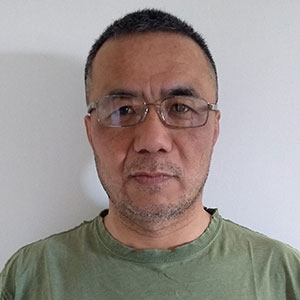Zhan-Guo Gao, M.D., Ph.D.

Professional Experience
- M.D., Medical College of Weifang, 1988
- M.Sci., Beijing Institute of Pharmacology and Toxicology, 1993
- Ph.D., Leiden University, 2000
Research Goal
The knowledge we gained by studying the structure, function, and regulation of G protein-coupled receptors (GPCRs) should be very useful for the development of drugs with highly improved therapeutic effects and fewer side effects.
Current Research
My principal research interests are centered on the structure, function, and regulatory mechanisms of GPCRs, especially adenosine receptors and P2Y nucleotide receptors. Allosteric modulation of GPCRs has been my main research project for the past 20 years. In addition to the traditional GPCR signaling studies, I am also interested in novel signaling pathways, including arrestin GPCR signaling, and in novel concepts such as functional selectivity. I am also interested in using mathematical models to quantify and analyze drug effects and mechanisms.
Applying Our Research
Our basic research can help the public understand the mechanisms of drug actions. It can also provide a basis for other scientists and the industry to develop novel drugs. Our application research may lead directly to the discovery and development of drugs.
Need for Further Study
Areas in this field that need further study include the structures and the dynamic nature of receptors, the signaling pathways related to receptors and various conditions, the novel roles of receptors, and the novel mechanisms of drug action.
Select Publications
- Genetic and functional modulation by agonist MRS5698 and allosteric enhancer LUF6000 at the native A(3) adenosine receptor in HL-60 cells.
- Gao ZG, Chen W, Gao RR, Li J, Tosh DK, Hanover JA, Jacobson KA.
- Purinergic Signal (2024 Oct) 20:559-570. Abstract/Full Text
- A(2B) adenosine receptor activation and modulation by protein kinase C.
- Gao ZG, Levitan IM, Inoue A, Wei Q, Jacobson KA.
- iScience (2023 Jul 21) 26:107178. Abstract/Full Text
Research in Plain Language
My research is in the field of pharmacology. My goal is to gain a better understanding of the ways that cells communicate with each other, and with certain medications, to help fight disease. I work on G protein-coupled cell surface receptors (GPCRs), with a focus on adenosine receptors and P2Y receptors. GPCRs are proteins on special areas of the cell membrane that are involved with cell communication. They are targets for a good portion of all medicines that we use today, acting as a sort of communications bridge between the drugs and the body’s cells. Adenosine receptors and P2Y receptors are two families of GPCRs that help deliver important drug messages for fighting many health conditions.

